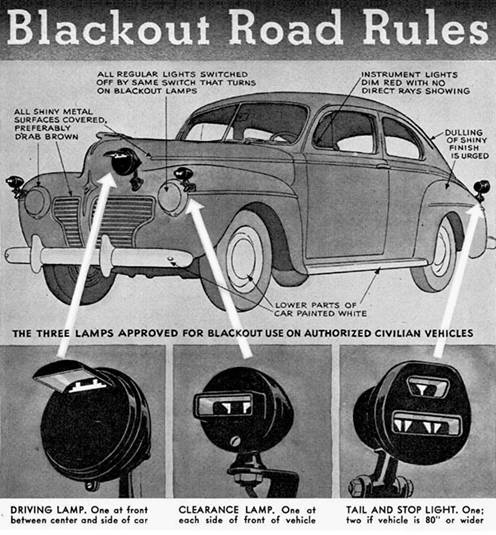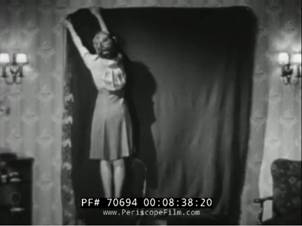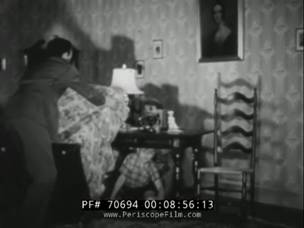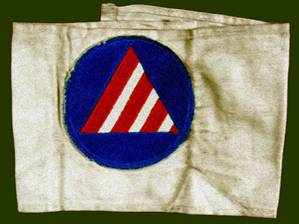Civilian Defense
In the quarter century between August 1914, when a Zeppelin dropped bombs on two Belgian cities, and September 1939, when the Luftwaffe strafed helpless Polish civilians who were fleeing an invading army, air raids against civilians had become an accepted part of warfare. Thus, in anticipation of America's] joining the war, the U.S. established the Office of Civilian Defense (not a typo) in May 1941. It existed to prepare Americans for the prospect of facing enemy attacks at home, and it primarily focused on air raid readiness. Americans would be instructed in two protocols: the Blackout, and the Air Raid Drill.
*
Blackouts
In 1941, flying long-distance bombing attacks was far more dangerous than flying shorter missions - the small, agile fighter aircraft needed to protect bombers simply could not carry enough fuel for long missions. It was safer to fly long distances in the dark, when your bomber was less visible. Thus, America believed that any long-distance enemy air raids on the 48 states would occur at night. Hence the concept of the Blackout, intended to darken an area so completely that enemy aircraft could not find the targets they sought.
The U.S. codified rules for Blackouts in 1942. Outdoor lights (signs, street lights, etc.) were to be extinguished. If a traffic light had to be left on, its lenses were to be shielded, rendering them invisible from above, and minimizing the light they cast below. Civilians needed special authorization to operate vehicles during Blackouts, and those vehicles had to be modified, as illustrated here:

Popular Science, September 1942
All powered vehicles (trucks, ambulances, police and fire vehicles, etc.) were subject to similar rules. Horse-drawn vehicles, pushcarts, and bicycles got their own rules, too. Pedestrians who had to be outside during Blackouts could carry no lighted matches, cigarettes, etc.; they had to wear dark clothing, preferably with white visibility wraps around their calves (so that drivers could see them); flashlights had to point straight down when in use.
Either indoor lights had to be turned off, or all windows in the rooms they illuminated had to be covered by light-tight material. During a Blackout, violations of these rules were enforced by Air Raid Wardens (see below) and, as necessary, by police.
*
Air Raid Drills
An Air Raid Drill might occur at night (and thus include a Blackout) or in the daytime. Any people who happened to be indoors were to take shelter wherever they were. Those who were outdoors had to proceed home or to public shelters, whichever was closest. Entrances to designated public shelters were marked with yellow signs. These shelters were usually below ground, and in schools, apartment buildings, or office buildings. Their chief purpose was to protect the people within against airborne debris from explosions, especially shards of window glass. Home cellars worked well. If a home lacked a cellar, a first-floor shelter area could be improvised beneath a large table (see below). Again, the main idea was to avoid citizens' being blinded or otherwise injured by flying glass.
Air Raid Wardens were essential. They cleared the streets, directing people to, and if necessary helping them into, shelters. The volunteer Wardens had gone through a standard training program and passed a final exam. They knew First Aid, Blackout and Air Raid protocols, how to recognize a variety of poisonous gases, coordinate with emergency services, and identify military aircraft, both domestic and foreign.

A woman hangs opaque fabric over her windows, so that her home's lights
cannot be seen from outside. Meanwhile, her husband puts a stuffed chair
between a window and the table under which his family will take shelter, to
block any shards of window glass sent flying by exploding bombs.
Yes, this was the domestic version of the "take cover"
school drills during which we ducked under our desks.

Both stills above are from an educational short by
Castle Films - narrated by Joe O'Brien, later a
WMCA Good Guy - which can be seen at
https://archive.org/details/70694CastleFilmAirRaidWarning

Wardens' helmets and armbands bore special logos - equilateral
triangles in red and white, contained in blue disks. Some
triangles had stripes, as shown above; others said 'CD.'
griffinmilitaria.com

The Air Raid Warden's job could be dangerous, especially in the dark. From a news
story about the extensive blackout tests that were conducted the
previous night in many parts of Long Island
The Brooklyn Eagle, May 15, 1942
***

